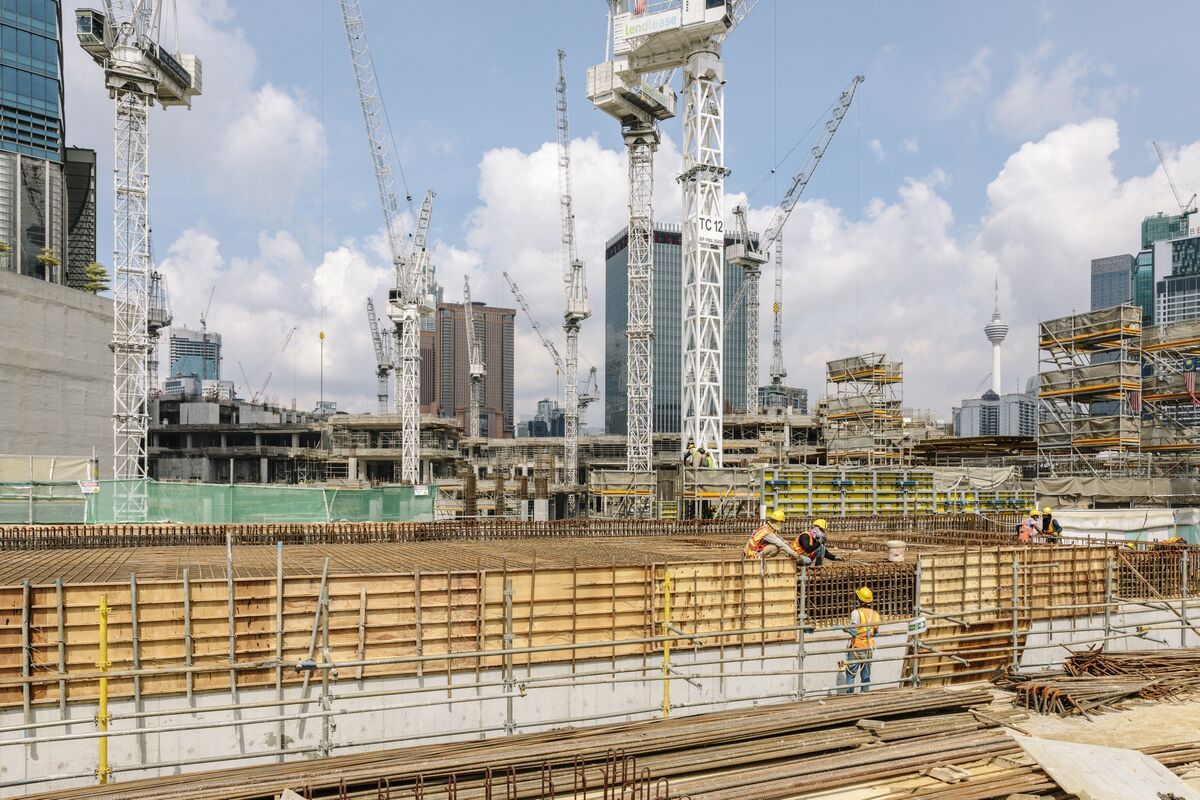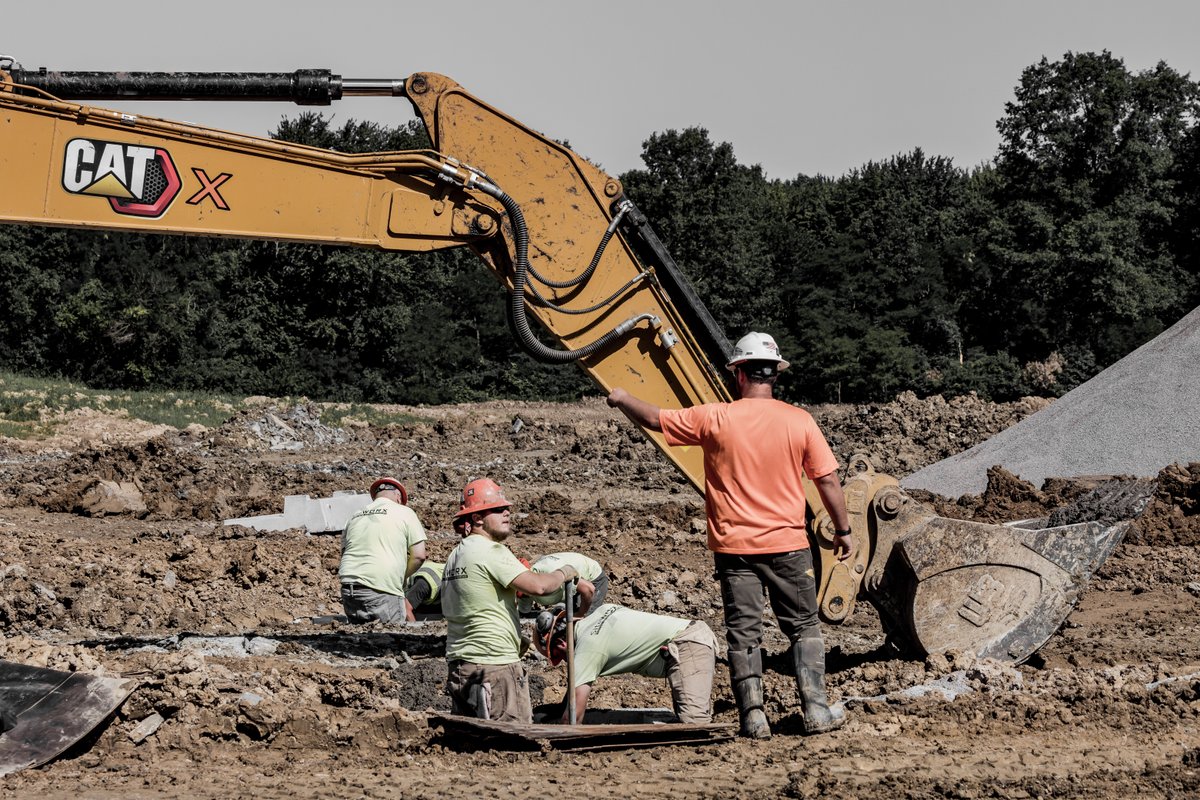Home>diy>Building & Construction>How Many People Work In The Construction Industry


Building & Construction
How Many People Work In The Construction Industry
Modified: January 24, 2024
Discover the number of individuals employed in the building construction sector with our comprehensive guide. Learn about the workforce in the construction industry today!
(Many of the links in this article redirect to a specific reviewed product. Your purchase of these products through affiliate links helps to generate commission for Storables.com, at no extra cost. Learn more)
Introduction
The construction industry plays a vital role in shaping the infrastructure of society. From towering skyscrapers to sturdy bridges and well-designed homes, construction projects bring imagination to life. But have you ever wondered how many people work in this dynamic and challenging industry?
In this article, we will delve into the world of construction and explore the number of individuals involved in this field. We will examine the factors that influence employment in the construction industry, explore regional variations in construction employment, and discuss projected growth and job opportunities. Additionally, we will shed light on the challenges faced by workers in this demanding profession.
So, let’s put on our hard hats and dig deeper into the fascinating world of the construction industry!
Key Takeaways:
- The construction industry employs over 7 million people in the United States, offering diverse career opportunities and contributing to economic growth through infrastructure development and renovation projects.
- Despite challenges such as physical demands and seasonal fluctuations, the construction industry presents promising job prospects, driven by factors like infrastructure development, renewable energy, and sustainable construction.
Read more: Why Work In The Construction Industry
Overview of the Construction Industry
The construction industry encompasses a wide range of activities, including the construction of buildings, civil engineering works, and infrastructure projects. It is a diverse field with various sectors such as commercial construction, residential construction, industrial construction, and public infrastructure development.
Construction projects are typically undertaken by a collaborative team of professionals, including architects, engineers, project managers, and skilled workers. These individuals work together from the planning and design stages through to the construction and completion of the project. The construction industry not only creates essential physical structures but also provides employment opportunities for millions of people worldwide.
From small-scale renovations to large-scale infrastructure projects, the construction industry is known for its dynamic nature and the constant demand for skilled labor. Be it constructing new buildings, renovating existing structures, or maintaining and repairing essential infrastructure, this industry is always bustling with activity.
The construction process involves various stages, including site preparation, foundation construction, structural erection, installation of utilities, and finishing touches. Each stage requires specific skill sets and expertise, with workers specializing in areas such as carpentry, plumbing, electrical work, masonry, and painting. Together, these skilled workers and professionals collaborate to bring construction projects to fruition.
As the construction industry is driven by economic growth, it often serves as an indicator of the overall health of the economy. During times of economic prosperity, construction projects proliferate, creating a surge in employment opportunities. On the other hand, economic downturns may lead to a slowdown in construction activities, impacting job prospects in the industry.
Now that we have gained a general understanding of the construction industry, let’s explore the factors that influence the number of workers in this field.
Factors Influencing the Number of Workers in the Construction Industry
Several factors influence the number of workers employed in the construction industry. These factors range from economic conditions and government policies to technological advancements and demographic changes. Let’s take a closer look at some of the key factors:
- Economic Conditions: The state of the economy has a significant impact on construction activity and subsequently affects employment levels in the industry. During times of economic growth and increased investment in construction projects, there is a higher demand for skilled workers, leading to a larger workforce. Conversely, economic recessions and downturns can result in reduced construction activity and a decline in employment opportunities.
- Government Policies and Regulations: Government policies and regulations related to infrastructure development, construction permits, and building codes can shape the demand for construction workers. Changes in regulations and incentives can influence the number of construction projects and impact employment levels in the industry.
- Technological Advancements: The adoption of technology in the construction industry can affect the number of workers needed for certain tasks. Automation, robotics, and Building Information Modeling (BIM) have streamlined construction processes, reducing the need for manual labor in some areas. However, technological advancements have also created new roles and increased the demand for workers with specialized skills in areas such as construction technology and digital modeling.
- Demographic Changes: The demographics of the population, including age distribution and migration patterns, can impact construction employment. An aging workforce may lead to a shortage of skilled workers, while population growth or shifts in urbanization can create a higher demand for construction workers to meet the needs of expanding cities and infrastructure development.
- Investment in Infrastructure: Government funding and private investment in infrastructure projects play a crucial role in determining the number of workers in the construction industry. Large-scale infrastructure projects, such as highways, airports, and public transportation systems, require a significant workforce for design, construction, and maintenance.
These are just a few of the many factors that influence the number of workers employed in the construction industry. It is essential for businesses, policymakers, and individuals considering a career in construction to remain cognizant of these factors and how they can shape employment opportunities in the field.
Now that we have explored some of the factors influencing employment in the construction industry, let’s delve into the employment statistics in this dynamic field.
Employment Statistics in the Construction Industry
The construction industry is known for its significant contribution to employment, providing job opportunities to millions of people worldwide. Let’s delve into some key employment statistics in the construction industry:
- In the United States, the construction industry employs over 7 million people, making it one of the largest sectors of the economy. It accounts for approximately 4% of total employment in the country.
- According to the Bureau of Labor Statistics, the projected growth rate for construction occupations from 2020 to 2030 is 5%, which is faster than the average for all occupations. This growth is attributed to the need for new infrastructure, renovations, and the increasing demand for energy-efficient and environmentally-friendly buildings.
- The construction industry is diverse, offering a wide range of career opportunities. It includes occupations such as carpenters, electricians, plumbers, masons, painters, project managers, architects, engineers, and many others.
- Construction jobs are often physically demanding and require specialized skills. They offer a mix of both entry-level positions and opportunities for advancement to supervisory and management roles.
- The construction industry provides employment opportunities both in urban and rural areas. While urban areas have a higher concentration of construction projects, rural areas also benefit from infrastructure development and construction of residential and commercial buildings.
- Construction workers play an essential role in building and maintaining essential infrastructure, including roads, bridges, schools, hospitals, and residential buildings. Their contributions are crucial to the growth and development of societies.
The construction industry is known for its cyclical nature, fluctuating with economic conditions. During periods of economic growth, construction employment tends to increase as more projects are initiated. However, during economic recessions or downturns, there may be a decline in construction activity and a subsequent decrease in job opportunities.
It is important to note that the construction industry also experiences seasonal fluctuations, with certain construction activities being more prevalent during specific times of the year (such as road construction during warmer months).
By understanding the employment statistics and the diverse range of opportunities available in the construction industry, individuals can make informed decisions about pursuing careers in this field. Now, let’s explore the regional variations in construction industry employment.
Tip: The construction industry employs over 7 million people in the United States alone, making it one of the largest and most important sectors for job opportunities.
Regional Variations in Construction Industry Employment
The construction industry’s employment landscape varies across regions, influenced by factors such as population density, economic conditions, infrastructure needs, and regional development policies. Let’s explore some of the regional variations in construction industry employment:
- Urban Centers: Urban areas with high population densities and rapid urbanization tend to have a higher demand for construction projects. These areas often experience a higher concentration of construction activities, including the construction of residential and commercial buildings, infrastructure development, and renovation projects. As a result, urban centers offer a wide range of construction job opportunities, attracting skilled workers from various trades.
- Rural Areas: Although rural areas typically have lower population densities, they still require construction and infrastructure development. Rural regions may have a specific focus on agricultural, industrial, or rural infrastructure projects. Construction employment in rural areas tends to be more localized and may involve specialized skills related to the specific needs of the region.
- Developing Regions: Developing regions and countries experiencing rapid economic growth often witness a surge in construction activities. These areas require extensive infrastructure development such as roads, bridges, airports, and utilities. The demand for construction workers in these regions is high, attracting both local and international skilled labor to support the growth and development initiatives.
- Government Initiatives: Regional variations in construction employment can also be influenced by government initiatives and policies aimed at promoting regional development and infrastructure projects. Governments may allocate budgets and implement incentives to encourage construction activities in specific regions, leading to variations in employment opportunities.
- Natural Disasters and Rebuilding Efforts: Regions that have experienced natural disasters, such as hurricanes, earthquakes, or floods, often require extensive rebuilding and construction efforts. These reconstruction projects create temporary employment booms, attracting workers from nearby regions to assist in the restoration and recovery efforts.
It’s important to note that while urban areas may have a higher volume of construction projects, competition for construction jobs can also be significant. Skilled workers may find ample opportunities in rural areas or developing regions, where their expertise is in demand and they can often benefit from a more favorable cost of living.
By being aware of the regional variations in construction industry employment, individuals can consider different job markets and target areas that align with their skills and career goals. Now, let’s explore the projected growth and job opportunities in the construction industry.
Read more: How Many People Are In The Garden
Projected Growth and Job Opportunities in the Construction Industry
The construction industry is expected to see continued growth and present various job opportunities in the coming years. Several factors contribute to this positive outlook. Let’s explore the projected growth and job opportunities in the construction industry:
- Infrastructure Development: Governments around the world are prioritizing infrastructure investments to support economic growth. This includes the construction of roads, highways, bridges, airports, and public transportation systems. The need for skilled workers in civil engineering, construction management, and various trades is expected to increase.
- Renewable Energy: The transition to renewable energy sources, such as wind and solar power, is driving the construction of new energy infrastructure. Building solar farms, wind turbines, and related transmission infrastructure requires skilled workers in construction, electrical work, and green energy technologies.
- Sustainable Construction: Increasing awareness of environmental sustainability is leading to a demand for green buildings and sustainable construction practices. This trend creates opportunities for workers with expertise in eco-friendly construction materials, energy-efficient systems, and environmentally-conscious design.
- Residential Construction: The need for housing continues to grow in both urban and suburban areas. Residential construction projects, including single-family homes, multi-family dwellings, and affordable housing initiatives, provide employment opportunities for construction workers, architects, and real estate professionals.
- Technological Advancements: The integration of technology in the construction industry is transforming construction processes and creating new job opportunities. Workers skilled in construction technology, digital modeling, and data analysis play a crucial role in improving efficiency, safety, and project management.
- Specialized Construction: There is a growing demand for specialized construction services in areas such as healthcare, education, and hospitality. Building hospitals, schools, and hotels requires construction workers with expertise in specific regulations and requirements for these industries.
While the construction industry offers promising job opportunities, it is important to note that certain challenges are faced by workers in this industry. Let’s explore some of these challenges in the next section.
By staying up-to-date with the projected growth areas and emerging trends in the construction industry, individuals can strategically position themselves to take advantage of the job opportunities that lie ahead.
Challenges Faced by Workers in the Construction Industry
The construction industry presents unique challenges for workers, stemming from the nature of the work and the industry itself. Let’s explore some of the common challenges faced by workers in the construction industry:
- Physical Demands: Construction work can be physically demanding, requiring individuals to perform tasks that involve heavy lifting, repetitive movements, and working in various weather conditions. This physical demand can lead to fatigue, injuries, and long-term health issues if proper safety measures aren’t followed.
- Health and Safety Risks: Construction sites can be hazardous environments with potential risks such as falls, electrical hazards, exposure to harmful substances, and accidents involving heavy machinery. Workers must adhere to strict safety protocols and wear appropriate protective gear to mitigate these risks. Employers must also prioritize the safety of their workers and provide proper training and safety measures.
- Seasonal Fluctuations: Certain construction activities are seasonal, such as road construction that is more prevalent during warmer months. This can lead to fluctuations in employment and income for construction workers, requiring them to adjust and seek alternative opportunities during the off-season.
- Skills Gap: The construction industry faces a skills gap, with a shortage of skilled workers in some areas. This can lead to increased competition for qualified workers and challenges in meeting project timelines and quality standards. To address this, it is crucial to invest in training and education programs to develop a skilled workforce.
- Project Delays and Uncertainty: Construction projects can face delays due to various factors such as weather, unforeseen circumstances, permit issues, or changes in project scope. This uncertainty can impact the stability of employment and financial well-being for workers, requiring adaptability and resilience.
- Work-Life Balance: Construction projects often involve long hours, tight deadlines, and the need to meet client expectations. This can result in a work-life imbalance, putting strain on personal relationships and overall well-being. It is essential for workers to prioritize self-care and maintain a healthy work-life balance.
Despite these challenges, many individuals find fulfillment in the construction industry, driven by the satisfaction of building tangible structures and contributing to the development of communities. To address these challenges, it is crucial for employers and industry stakeholders to prioritize the well-being and safety of workers, provide adequate training and support, and foster a positive work environment.
Now that we have explored the challenges faced by workers in the construction industry, let’s conclude our article.
Conclusion
The construction industry is a dynamic and essential sector that shapes the world we live in. From towering skyscrapers to intricate bridges, the industry brings architectural visions to life. Throughout this article, we have explored various aspects of the construction industry, including the number of workers, factors influencing employment, regional variations, employment statistics, projected growth, and challenges faced by workers.
Employment in the construction industry is influenced by factors such as economic conditions, government policies, technological advancements, and demographic changes. Additionally, the industry offers a wide range of job opportunities, from skilled tradespeople to architects and engineers, contributing to economic growth and societal development.
Evidence suggests that the construction industry will witness continued growth in the coming years across various sectors, including infrastructure development, renewable energy, and sustainable construction. However, workers in the construction industry encounter challenges, including physical demands, health and safety risks, seasonal fluctuations, skills gap, project uncertainties, and work-life balance. Addressing these challenges requires a collaborative effort from industry stakeholders to prioritize worker well-being, safety, and skill development.
Despite the challenges, the construction industry remains an attractive field for individuals seeking meaningful work and the opportunity to contribute to the physical development of communities. It requires a diverse range of skills and expertise, providing avenues for career advancement and personal growth. As the industry continues to evolve, embracing technological advancements and sustainable practices, it will offer endless possibilities for innovation and job opportunities.
In conclusion, the construction industry plays a vital role in creating the built environment that surrounds us. It is a dynamic and challenging field, offering employment and contributing to economic growth. By understanding its intricacies, we can appreciate the dedication and skill of the individuals who tirelessly work to shape our infrastructure and create a better future.
Frequently Asked Questions about How Many People Work In The Construction Industry
Was this page helpful?
At Storables.com, we guarantee accurate and reliable information. Our content, validated by Expert Board Contributors, is crafted following stringent Editorial Policies. We're committed to providing you with well-researched, expert-backed insights for all your informational needs.















0 thoughts on “How Many People Work In The Construction Industry”